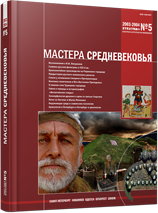Предыстория русского кожевенного ремесла
A Pre-History of the Russian Leather Trade
Author(s): Alexandr V. KurbatovSubject(s): History, Economic history, Middle Ages, 6th to 12th Centuries
Published by: Издательский дом Stratum, Университет «Высшая антропологическая школа»
Summary/Abstract: The paper is an attempt to analyze archaeological, ethnographic and various written evidence which can serve for a reconstruction of leather trade with the early Slavs. Reconstruction is suggested for the stages in the development of forms of footwear in Eastern Europe, change of constructions and styles in its design. Scarce archaeological finds and written accounts have made the researcher involve evaluation of a wide range of analogues known across the Eurasian continent. For the Bronze Age, for instance, petroglyphs are a source to reconstruct footwear. These include sites found in the North-West of Russia - the rock “Shcheglets” in Novgorod oblast’ and the recently discovered rock with petroglyphs in Tver. Their similarity with the North-European petroglyphs, almost the same natural and geographic environment, similar dynamic changes of material culture enable one considering development of footwear forms and methods of leather processing in clan communities in the northern part of Western Europe analogous to the processes that took place with the earliest Slavs who later spread in the forest region of Eastern Europe. Groups of Eastern Slavs populating forest-steppe territories must have borrowed traditions of the nomadic population of the steppe region of Eastern Europe. This nomadic population kept changing across millennia, but preserved traditional nomadic economy and life. Moreover, one must take into account the influence of the Greek-Roman civilization upon the early Slavs; it pronounced itself both in development of the national forms of clothes and in technical organization of the trade in the late Roman and early medieval period. The meaning of these three factors playing a role in development of the traditional leather trade with the Slavs will most likely be defined more specifically, based, primarily, on new archaeological data.
Journal: Stratum plus. Археология и культурная антропология
- Issue Year: 2004
- Issue No: 5
- Page Range: 283-304
- Page Count: 22
- Language: Russian
- Content File-PDF

